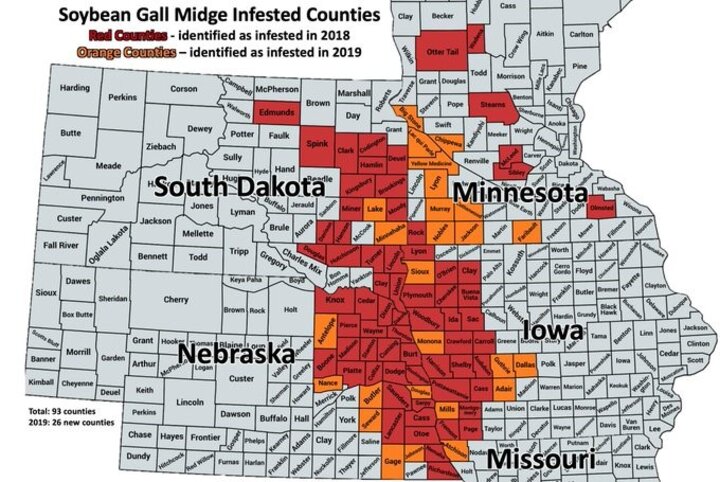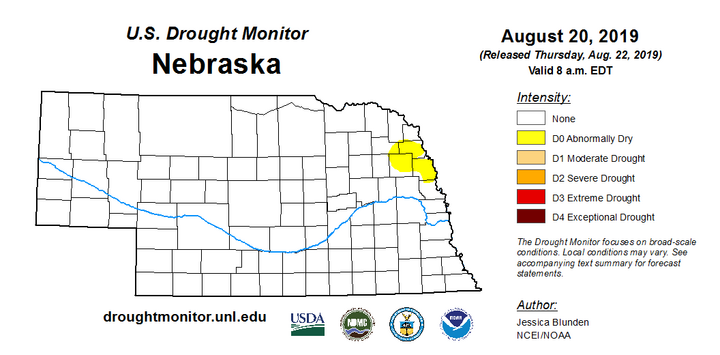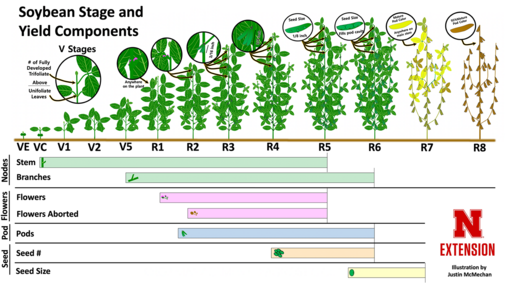Images link to larger versions.


After hanging out in southern Nebraska, #SouthernRust has headed north to visit @tjcksn... time to add Knox county to the map. @UNL_CropWatch @corndisease https://t.co/3cfpoCAwj9 pic.twitter.com/y8Hf5p7V9Y
— UNLPlant&Pest Clinic (@UNLPlantClinic) August 21, 2019
Keith Glewen, Extension Educator and Neil Dominy, NRCS discuss soil forming factors at Soil Health Clinic at ENREC near Mead @UNL_CropWatch pic.twitter.com/ChMRAC9KuZ
— SAREMAN (@glesoing2) August 22, 2019
John Wilson, Extension Educator in Burt County: Crops are looking surprisingly good, given it's been dry here. Humidity is high. I've gotten a first report of corn starting to dent in an early planted field. (8/20/19)
Justin McMehan, Extension Crop Protection and Cropping Systems Specialist: Soybean gall midge has now been confirmed in Gage County, thanks to identification by Kyle Broderick, UNL Plant and Pest Diagnostic Clinic. It has now been confirmed in 93 counties in five states. Plant symptoms are still developing in some areas.(8/20/19)
Kyle Broderick, coordinator of the UNL Plant and Pest Diagnostic Clinic: We’re finding dectes stem borer in soybean samples from southern Nebraska. Frogeye leaf spot, brown spot, and sudden death of soybeans have been confirmed across Nebraska. In corn we're seeing northern corn leaf blight as well as bacterial leaf streak, grey leaf spot, common and southern rust, and stalk rots (fusarium, anthracnose, and pythium). There’s already been a lot of spraying which may take care of some of this. If growers are starting to see symptoms of stalk rot, such as upper leaves flaring, they might want to prepare for an early harvest, especially if the field was in standing water for quite a while.(8/20/19)
Ron Seymour, Extension Educator in Adams County: Crops look pretty good. Corn is in the hard dough stage and moving into dent. We’ve had grey leaf spot, bacterial leaf streak, and common rust, but we haven’t seen northern blight as much. We’ve had corn earworm and western bean cutworm damage. Soybeans are well into pod-fill. We’ve seen a lot of insect feeding, but not much disease in soybean. It’s been a little dry in the southern part of the county and growers are irrigating as normal.(8/20/19)
Sarah Sivits, Extension Educator in Dawson County: Corn growth stages are pretty variable due to flooding and planting delays. Corn is mostly in the dough stage and some early planted fields are moving into dent. We’re seeing gray leaf spot, bacterial leaf streak, and common rust. Soybean growth stage depends on planting date, but most are in R3-R5. We’re seeing some phytophthora, stem canker, brown spot, bean leaf beetles and painted lady butterflies. Alfalfa growers are just taking their third or fourth cutting. Some of our growers have only irrigated two to three times. I’m seeing a lot of grasshoppers in ditches.(8/20/19)
Wayne Ohnesorg, Extension Educator in Madison County: It’s been really quiet the last couple of weeks. The painted lady butterflies have moved on. Growers with sandy soils have been irrigating for three to four weeks.(8/20/19)
John Thomas, Extension Educator in Box Butte County: Last week and again this week in some areas we had severe hail that damaged fields and property (buildings, cars). Moisture from a series of storms slowed wheat harvest, which is done in the southern Panhandle, but has a ways to go in the northern Panhandle. In this area proteins are averaging around 10% and yields have been 40-50 bu/ac and as high as 100 bu/ac on “dryland.” We’ve had some much moisture this year that the dryland acres aren’t typical. We’ve had a lot of wheat stem sawfly and moderate lodging. It’s not our worst year, but wheat stem sawfly will have a significant impact in some areas.(8/20/19)
Kat Caswell, Extension Educator in Red Willow County: We’ve had scattered showers every now and then and crops are looking pretty good here. Wheat harvest is pretty much done, but we’re seeing a lot of volunteer wheat, as well as some grasshoppers. We’re also seeing more tillage in fallow, where growers lost control of the weeds early season.(8/20/19)

